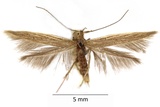Coleophora asteris Mühlig, 1864 Species
Last modified: Nov. 27, 2025, 6:45 p.m.
A very rare species in Belgium, hitherto only found at the coast and along the river Scheldt.
Details
- Classification
- Family: Coleophoridae > Genus: Coleophora > Species: Coleophora asteris
- Vernacular names
- Asterkokermot (NL), Sea-aster case-bearer (EN), Astern-Sackmotte (DE)
- First mention in Belgium
- Janmoulle E. 1955a. Espèces nouvelles pour la faune belge (suite). — Lambillionea 55: 3–4, 53–54, 82. On page 53.
- Status
-
Native
Distribution
Imago
Wingspan 10–15 mm.
This moth has ochre-coloured forewings with a lot of creamy longitudinal lines.
The leading edge of the forewing is white from the base to just over half its length. Often, and especially on fresh specimens, there are small scattered scales all over the wings.
The antennae are rather vaguely ringed to 3/4 of their length and have black spots on the underside.
Case
The dark brown silken and cigar-shaped case has a slight wrinkling, is about 6 mm in length, and is covered in seed hairs in autumn. After wintering these are often worn off which might create confusion with the cases of C. obscenella, a species not yet observed in Belgium. The mouth angle is 90°.
See also bladmineerders.be.
Bionomics
Eggs are oviposited on the flowers of the host plant. The larvae feed on the seeds till they are fully grown in September–October.
They subsequently leave their hostplant, overwinter in debris and pupate in late spring.
Flight periods
The adult moths are on the wing from June till September.
Observed on
- Host plant (species):
- Tripolium panniconum
This species feeds monophagously on Tripolium pannonicum.



